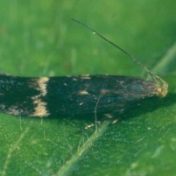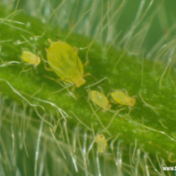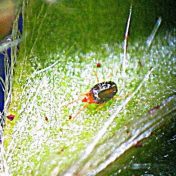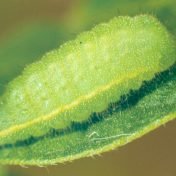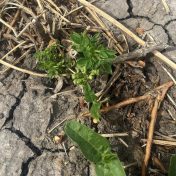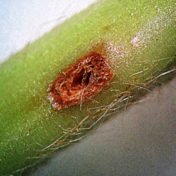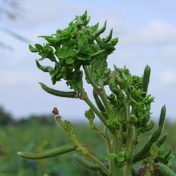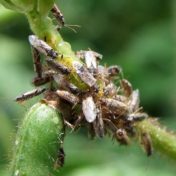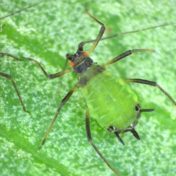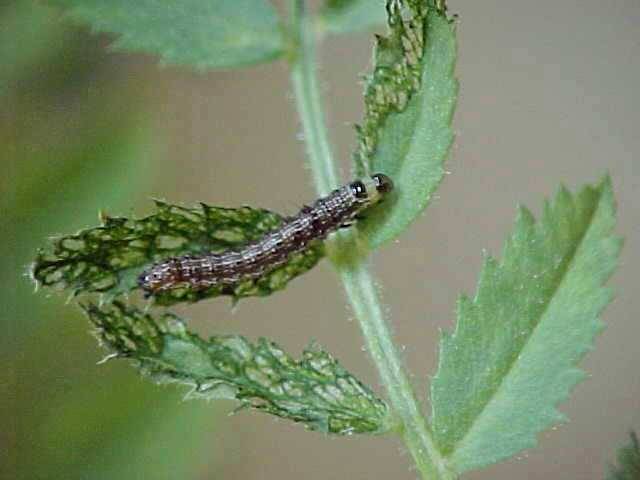Significant soybean moth flights have been observed recently in some coastal Burnett soybean crops. Little damage has been observed to date, but high numbers of adult moths are an early warning sign of potential severe defoliation. Soybean moth is usually a minor soybean pest but in spasmodic major outbreaks, larval populations can exceed 1,000 per square metre. Identification Soybean moths… Read more »
Significant soybean aphid (Aphis glycines) populations have now been observed in many coastal soybean crops. Once the crop approaches late flowering, a spray decision must be made as later aphid infestations can severely delay harvest maturity. Careful monitoring is required to determine if populations are trending upwards to and beyond threshold levels, or if the aphids are being contained by… Read more »
Peanut mite (Paraplonobia sp.) outbreaks have been widely reported in Burnett peanut crops from Kingaroy to Coulston Lakes. This is not surprising as these mites are favoured by prolonged hot dry weather as has been experienced lately. The first sign that these mites are present are plants with pale leaves. On closer inspection, fine feeding stipples are evident on the… Read more »
A major outbreak of grass blue butterfly (GBB) (Zizina labradus) in late vegetative and flowering soybeans has been reported in the Maryborough/Hervey Bay region. Some crops inspected had 10-12 GBB larvae per square metre with many plants denuded of buds and flowers. Other crops had less damage and fewer larvae (4-5 per square metre), but had 5 or more adult butterflies… Read more »
Phytoplama has been reported in second flower flushes in mungbeans, and also in harvested mungbean regrowth! So far the overall incidence of phytoplasma has been lower than this time last year, but growers and consultants are urged to keep monitoring their crops for the first symptoms of this disease, and to report any outbreaks. Many January-planted mungbean crops are at… Read more »
UPDATE: Crop progress report (March 2018) Recent photos of the crop where a stem fly infestation was reported in early February show signs of stem fly pupation, but no crop stress symptoms (i.e. no yellow and dying leaves), indicating that managing the outbreak when it was first detected would have been a waste of time and money (assuming there will… Read more »
Last summer saw unprecedented levels of phytoplasma in summer pulses/legumes (including chickpeas, mungbeans and pigeon peas) in all cropping regions in eastern and northern Australia from the Ord Irrigation area (WA), Burdekin/Atherton Tablelands (NQ), to central NSW. The most likely insect vector is the brown leafhopper Orosius orientalis, which has been detected in recent (2017) spring crops. While plantings of… Read more »
Although typically only in low numbers in the Northern Grains region, Rutherglen bugs (RGB; Nysius vinitor) were observed at very high densities (e.g. 50 RGB per pod) in many crops last year. A glasshouse study was conducted to determine at what plant stage mungbeans were most susceptible to RGB damage, in terms of both yield and seed quality. To do… Read more »
Megoura crassicauda has been found in parts of north-east and central New South Wales (Sydney, Tamworth, and Breeza). The species originated in north-east Asia, and is closely related to the vetch aphid (Megoura viciae), found in Europe, Ethiopia and North America. Its host range is mostly limited to Vicia species – vetches, faba or broad beans, and may extend to… Read more »
Helicoverpa are the primary insect pest of chickpeas. Beneficial insects that are present in many crops do not thrive in chickpeas, so successful helicoverpa management relies heavily on monitoring and identification, appropriately timing control to crop stage, and using the recommended thresholds. Monitoring involves regular in-field checking with a beat sheet. Additionally, moth numbers can be monitored using pheromone traps… Read more »
